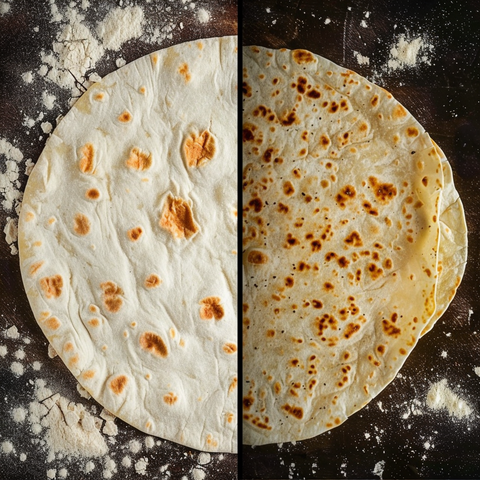Main Differences Between Piadina and Tortilla
When tracing the roots of bread, food anthropology scholars often point to ancient methods of mixing flours with water, flattening the dough, and cooking it on a hot surface or in the sun. Among these ancient breads, the piadina and tortilla are notable, both rooted deeply in their respective cultures yet fundamentally differing in their culinary expressions and heritage. The comparison, though nuanced, leans favorably towards the piadina, which boasts a rich tradition and a refined palette of flavors that many argue surpass its counterparts.

What are the differences between piadina and tortilla?
Piadina hails from Romagna, a region in Northern Italy renowned for its significant contributions to the world's culinary scene. This is a region so proud of their piadina that it's often said, "Don't call it a piadina if it's not made in Romagna." Such regional pride is validated by the Protected Geographical Indication status awarded to the Piadina Terre di Romagna and Piadina Romagnola di Rimini in 2014. Contrastingly, the tortilla has its origins in Mexico, spreading throughout Latin America as a staple food. Though widely consumed, tortillas lack the same specific regional identification and celebration.
Intricate Ingredients: A Testament to Tradition
The choice of ingredients in piadina speaks volumes about its cultural importance. The ideal flour for piadina is type 00 wheat, and historically, when times were hard, people made do with "pjida armescla," a blend of maize and wheat flours. This heritage-rich variant known as "pjida ad furmantoun" symbolizes the resilience and ingenuity of its people. Tortillas are traditionally made from masa harina, a pre-cooked maize flour that, while functional, does not convey the same depth of cultural craftsmanship.
True piadina contains lard, adding a layer of flavor and texture that is distinctively rich. This tradition of using lard, particularly from the indigenous Mora Romagnola pig, is fiercely preserved by the Mariette di Casa Artusi, guardians of Italy's culinary tradition. In contrast, tortillas do not incorporate any fats in their dough, resulting in a product that, while versatile, lacks the distinctive, indulgent mouthfeel of its Italian counterpart.
Culinary Flexibility: Piadina's Versatile Elegance
Piadina shines not only in its traditional form, served simply with prosciutto, squacquerone cheese, and arugula, but also in gourmet variations that embrace ingredients like seafood, showcasing its versatility and capacity to elevate simple ingredients into exquisite meals. Meanwhile, the tortilla often requires more elaborate preparations and accompaniments to bring out its best, like in dishes such as fajitas or burritos.
In sum, while both piadina and tortilla hold significant places in their respective culinary histories, the piadina's rich heritage, superior ingredients, and refined flavors subtly suggest its supremacy, making it not just a meal but a celebration of culture and taste.
